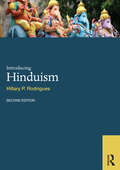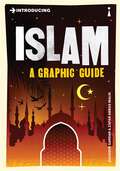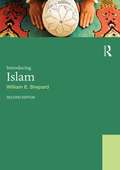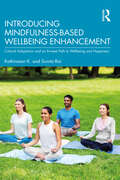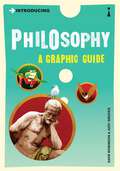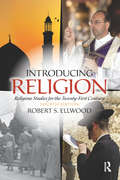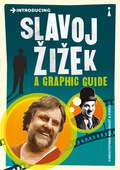- Table View
- List View
Introducing Hinduism (World Religions Ser. (PDF))
by Hillary RodriguesIntroducing Hinduism is the ideal starting point for students wishing to undertake a comprehensive study of this fascinating religion. This lively introduction explores the complexities of Hinduism, including its social structures, especially its caste system, its rituals and many scriptures, its vast mythology and varieties of deities, and its religious philosophies. Hillary Rodrigues, an experienced teacher of the Hindu tradition, emphasises the importance of Hindu rituals and practice, subjects of particular interest in contemporary scholarship. Illustrated throughout, the book also includes text boxes, summary charts, a glossary and a list of further reading to aid students' understanding and revision. The accompanying webstie to this book can be found at http://www.routledge.com/textbooks/0415392691.
Introducing Hinduism (World Religions)
by Hillary P. RodriguesIntroducing Hinduism, 2nd Edition is the ideal sourcebook for those seeking a comprehensive overview of the Hindu tradition. This second edition includes substantial treatments of Tantra, South India, and women, as well as expanded discussions of yoga, Vedanta and contemporary configurations of Hinduism in the West. Its lively presentation features: case studies, photographs, and scenarios that invite the reader into the lived world of Hinduism; introductory summaries, key points, discussion questions, and recommended reading lists at the end of each chapter; narrative summaries of the great epics and other renowned Hindu myths and lucid explanations of complex Indian philosophical teachings, including Sankhya and Kashmir Saivism; and a glossary, timeline, and pronunciation guide for an enhanced learning experience. This volume is an invaluable resource for students in need of an introduction to the key tenets and diverse practice of Hinduism, past and present.
Introducing Hinduism (World Religions)
by Hillary P. RodriguesIntroducing Hinduism, 2nd Edition is the ideal sourcebook for those seeking a comprehensive overview of the Hindu tradition. This second edition includes substantial treatments of Tantra, South India, and women, as well as expanded discussions of yoga, Vedanta and contemporary configurations of Hinduism in the West. Its lively presentation features: case studies, photographs, and scenarios that invite the reader into the lived world of Hinduism; introductory summaries, key points, discussion questions, and recommended reading lists at the end of each chapter; narrative summaries of the great epics and other renowned Hindu myths and lucid explanations of complex Indian philosophical teachings, including Sankhya and Kashmir Saivism; and a glossary, timeline, and pronunciation guide for an enhanced learning experience. This volume is an invaluable resource for students in need of an introduction to the key tenets and diverse practice of Hinduism, past and present.
Introducing Hinduism (PDF)
by Hillary P. RodriguesIntroducing Hinduism, 2nd Edition is the ideal sourcebook for those seeking a comprehensive overview of the Hindu tradition. This second edition includes substantial treatments of Tantra, South India, and women, as well as expanded discussions of yoga, Vedanta and contemporary configurations of Hinduism in the West. Its lively presentation features: case studies, photographs, and scenarios that invite the reader into the lived world of Hinduism; introductory summaries, key points, discussion questions, and recommended reading lists at the end of each chapter; narrative summaries of the great epics and other renowned Hindu myths and lucid explanations of complex Indian philosophical teachings, including Sankhya and Kashmir Saivism; and a glossary, timeline, and pronunciation guide for an enhanced learning experience. This volume is an invaluable resource for students in need of an introduction to the key tenets and diverse practice of Hinduism, past and present.
Introducing Islam: A Graphic Guide (Introducing...)
by Ziauddin SardarIslam is one of the world's great monotheistic religions. Islamic culture, spanning 1,500 years, has produced some of the finest achievements of humanity. Yet the religion followed by a fifth of humankind is too often seen in the West in terms of fundamentalism, bigotry and violence- a perception that couldn't be more wrong. Introducing Islam recounts the history of Islam from the birth of Prophet Muhammad in the 6th century to its status as a global culture and political force today. Charting the achievements of Muslim civilisation, it explains the nature and message of the Qur'an, outlines the basic features of Islamic law, and assesses the impact of colonialism on Muslim societies. Ziauddin Sardar and Zafar Abbas Malik show how Muslims everywhere are trying to live their faith and are shaping new Islamic ideas and ideals for a globalised world.
Introducing Islam (PDF)
by William ShepardJust what is Islam and what does it mean to be a Muslim in the world today? Since the events of 9/11 and 7/7, Islam has become one of the most controversial and misunderstood religions in the world. Introducing Islam encourages students to put aside their preconceptions and explore this fascinating religion. William Shepard traces the history of Islam from its origins in the life and career of Mohammed, through its classical expressions, to its interactions with the West in the modern world. A chapter is devoted to each major topic, including The Quran, Islamic law, Islamic theology, and the Sufi movement, as well as community rituals and Islamic art and culture. There is a survey of modern developments and four chapters are dedicated to individual countries, Turkey, Iran, Egypt and Indonesia. Fully revised and updated, the second edition of this core textbook adds crucial material on contemporary issues such as women in Islam and democratization and human rights. Illustrated throughout, the book also includes learning objectives, a glossary of key Arabic terms, comprehensive further reading lists and critical thinking boxes, helping students to critically engage with the material in each chapter. Further teaching and learning resources are available on the companion website at www.routledge.com/cw/shepard .This book continues to be essential reading for students of Islam worldwide.
Introducing Jesus: A Graphic Guide (Introducing...)
by Anthony O'HearChristianity depends on the belief that the Jesus of history is identical with the Christ of faith, and that God in the person of Jesus intervened finally and decisively in human history. But is the historical Jesus the same as the Christian Saviour? And how did an obscure provincial religion based on the paradox of a crucified saviour conquer the Roman Empire and outlive it? INTRODUCING JESUS - A GRAPHIC GUIDE confronts the enigmas. It sets Jesus in the perspective of his time - within Judaism and its expectations of a Messiah, in the atmosphere of Greek philosophy and the Roman deification of emperors. It traces the development of Christianity from St. Paul and the Romanization of the Church, to modern liberation theology. This book is a lucid and exciting investigation that will appeal to all readers, whether Christian or not.
Introducing Kierkegaard: A Graphic Guide (Introducing...)
by Dave RobinsonFather of existentialism or the Eeyore of philosophy? Known as the first modern theologian, Søren Kierkegaard was a prolific writer of the Danish ‘golden age’. A philosopher, poet and social critic, his key concepts of angst, despair, and the importance of the individual, influenced many 20th-century philosophers and literature throughout Europe. Dave Robinson and Oscar Zarate’s brilliant graphic guide explains what Kierkegaard means by 'anti-philosophy', and tells an illuminating story of the strange life and ideas of a man tortured by his attempts to change the very priorities of Western thought.
Introducing Mindfulness-Based Wellbeing Enhancement: Cultural Adaptation and an 8-week Path to Wellbeing and Happiness
by Kathirasan K. Sunita RaiMindfulness-Based Wellbeing Enhancement (MBWE) integrates Mindfulness and Wellbeing to realize human flourishing and the attainment of happiness. This 9-session program, conducted over 8 weeks, enhances wellbeing, happiness and quality of life through self-understanding and self-awareness. The first part of the book is devoted to presenting mindfulness, wellbeing, the happiness paradigm and the curriculum of the Mindfulness-Based Wellbeing Enhancement (MBWE) program. It presents the foundations of mindfulness-based programs, and how mindfulness intersects with wellbeing. The authors argue, with the support of evidence, that mindfulness is well placed to promote human flourishing rather than limiting its relevance to stress reduction and preventing depression relapse. Several chapters are devoted to presenting the MBWE program comprehensively with weekly agendas, homework, handouts, facilitation guides and practice scripts. The second part of the book presents the evidence base of mindfulness, cultural adaptations for different populations, the therapeutic effectiveness of group learning inherent in Mindfulness-Based Programs and the often-untold history of mindfulness. The authors present the often-neglected Asian roots of Mindfulness and justify how secular Mindfulness, as taught by Jon Kabat-Zinn, is influenced by multiple wisdom traditions as opposed to it being a solely Buddhist practice. This book serves as a hands-on resource for trained mindfulness teachers, psychologists, psychiatrists, psychotherapists, counsellors, social workers, practitioners, educators, coaches, and consultants. It is also suitable for anyone who is interested in the appreciation of mindfulness and human flourishing.
Introducing Mindfulness-Based Wellbeing Enhancement: Cultural Adaptation and an 8-week Path to Wellbeing and Happiness
by Kathirasan K. Sunita RaiMindfulness-Based Wellbeing Enhancement (MBWE) integrates Mindfulness and Wellbeing to realize human flourishing and the attainment of happiness. This 9-session program, conducted over 8 weeks, enhances wellbeing, happiness and quality of life through self-understanding and self-awareness. The first part of the book is devoted to presenting mindfulness, wellbeing, the happiness paradigm and the curriculum of the Mindfulness-Based Wellbeing Enhancement (MBWE) program. It presents the foundations of mindfulness-based programs, and how mindfulness intersects with wellbeing. The authors argue, with the support of evidence, that mindfulness is well placed to promote human flourishing rather than limiting its relevance to stress reduction and preventing depression relapse. Several chapters are devoted to presenting the MBWE program comprehensively with weekly agendas, homework, handouts, facilitation guides and practice scripts. The second part of the book presents the evidence base of mindfulness, cultural adaptations for different populations, the therapeutic effectiveness of group learning inherent in Mindfulness-Based Programs and the often-untold history of mindfulness. The authors present the often-neglected Asian roots of Mindfulness and justify how secular Mindfulness, as taught by Jon Kabat-Zinn, is influenced by multiple wisdom traditions as opposed to it being a solely Buddhist practice. This book serves as a hands-on resource for trained mindfulness teachers, psychologists, psychiatrists, psychotherapists, counsellors, social workers, practitioners, educators, coaches, and consultants. It is also suitable for anyone who is interested in the appreciation of mindfulness and human flourishing.
Introducing Nietzsche: A Graphic Guide (Introducing... #0)
by Laurence Gane PieroWhy must we believe that God is dead? Can we accept that traditional morality is just a 'useful mistake'? Did the principle of 'the will to power' lead to the Holocaust? What are the limitations of scientific knowledge? Is human evolution complete or only beginning? It is difficult to overestimate the importance of Friedrich Nietzsche for our present epoch. His extraordinary insights into human psychology, morality, religion and power seem quite clairvoyant today: existentialism, psychoanalysis, semiotics and postmodernism are plainly anticipated in his writings - which are famously enigmatic and often contradictory."Introducing Nietzsche" is the perfect guide to this exhilarating and oft-misunderstood philosopher.
Introducing Philosophy: A Graphic Guide (Introducing... #0)
by Dave Robinson Judy GrovesPhilosophers have always enjoyed asking awkward and provocative questions, such as: What is the nature of reality? What are human beings really like? What is special about the human mind and consciousness? Are we free to choose who we are and what we do? Can we prove that God exists? Can we be certain about anything at all? What is truth? Does language provide us with a true picture of the world? How should we behave towards each other? Do computers think? Introducing Philosophy is a comprehensive graphic guide to the thinking of all the significant philosophers of the Western world from Heraclitus to Derrida. It examines and explains their key arguments and ideas without being obscure or solemn. Lively and accessible, it is the perfect introduction to philosophers and philosophical ideas for anyone coming to the subject for the first time.
Introducing Philosophy of Religion
by Chad MeisterDoes God exist? What about evil and suffering? How does faith relate to science? Is there life after death? These questions fascinate everyone and lie at the heart of philosophy of religion. Chad Meister offers an up-to-date introduction to the field, focussing not only on traditional debates but also on contemporary concepts such as the intelligent creator. Key topics, such as divine reality and the self and religious experience, are discussed in relation to different faiths. Introducing Philosophy of Religion: • offers a lucid overview of contemporary philosophy of religion• introduces the key figures in the history of philosophy of religion • explores the impact of religious diversity and pluralism • examines the main arguments for and against the existence of God and the nature of the divine • looks at science and issues of faith and reason • explores how the different religions approach the concept of life after death. The wealth of textbook features, including tables of essential information, questions for reflection, summaries, glossary and recommendations for further reading make the book ideal for student use. Along with its accompanying Reader, this is the perfect introductory package for undergraduate philosophy of religion courses. Visit the book's companion website at www.routledge.com/textbooks/9780415403276. Features include: an interactive glossary a timeline powerpoint slides on all the chapters chapter outlines lists of objectives for study.
Introducing Philosophy of Religion
by Chad MeisterDoes God exist? What about evil and suffering? How does faith relate to science? Is there life after death? These questions fascinate everyone and lie at the heart of philosophy of religion. Chad Meister offers an up-to-date introduction to the field, focussing not only on traditional debates but also on contemporary concepts such as the intelligent creator. Key topics, such as divine reality and the self and religious experience, are discussed in relation to different faiths. Introducing Philosophy of Religion: • offers a lucid overview of contemporary philosophy of religion• introduces the key figures in the history of philosophy of religion • explores the impact of religious diversity and pluralism • examines the main arguments for and against the existence of God and the nature of the divine • looks at science and issues of faith and reason • explores how the different religions approach the concept of life after death. The wealth of textbook features, including tables of essential information, questions for reflection, summaries, glossary and recommendations for further reading make the book ideal for student use. Along with its accompanying Reader, this is the perfect introductory package for undergraduate philosophy of religion courses. Visit the book's companion website at www.routledge.com/textbooks/9780415403276. Features include: an interactive glossary a timeline powerpoint slides on all the chapters chapter outlines lists of objectives for study.
Introducing Philosophy of Religion (PDF)
by Dilwyn Hunt'Introducing Philosophy of Religion' provides an exciting and student-focused approach to this key topic. The book is designed to give students an accessible route into a subject that challenges everyday ways of thinking.
Introducing Redemption in Christian Feminism (Introductions in Feminist Theology)
by Rosemary Radford RuetherChristianity begins with what appears to be an inclusive promise of redemption in Christ without regard to gender. Paul proclaimed that 'In Christ there is no more male and female.' Yet Christianity soon developed a patriarchal social structure, excluding women from public ministry, with the argument that women were created subordinate in nature and were more culpable for sin. Here, distinguished feminist theologian, Rosemary Ruether, traces the tension between patriarchal and egalitarian patterns in Christian theology historically. She then examines key theological themes--Christology, the self, the cross and future hope--in the light of her critique.
Introducing Religion: Essays in Honor of Jonathan Z.Smith
by Willi Braun Russell T. McCutcheonThe study of religion encompasses ordinary human social practice and is not limited to the extraordinary or divine. 'Introducing Religion' brings together leading international scholars in the field of religious studies to examine religion as integral to everyday social practice. The book establishes a theoretical framework for the study of religion to analyse prayer, ritual, science, morality and politics in relation to the world's major religions. It will be of interest to students of theory and method in religious studies seeking a clear introduction to the multifaceted nature of religion.
Introducing Religion: Essays in Honor of Jonathan Z.Smith
by Willi Braun Russell T. McCutcheonThe study of religion encompasses ordinary human social practice and is not limited to the extraordinary or divine. 'Introducing Religion' brings together leading international scholars in the field of religious studies to examine religion as integral to everyday social practice. The book establishes a theoretical framework for the study of religion to analyse prayer, ritual, science, morality and politics in relation to the world's major religions. It will be of interest to students of theory and method in religious studies seeking a clear introduction to the multifaceted nature of religion.
Introducing Religion: Religious Studies for the Twenty-First Century
by Robert EllwoodIntroducing Religion, 4/e explores the different ways of looking at religion in the twenty-first century. A broad overview to religious studies as a discipline introduces students to the various subjects of religion. Introducing Religion teaches readers how to think in academic religious studies and its main areas, including: sociology of religion, psychology of religion, history of religion, religion and art, ethics, and more. The fourth edition has been expanded with new chapters exploring topics of contemporary interest: myth, spiritual paths, religion and popular culture, religion in the computer age, religion and war. Contemporary topics engage today’s students, relating the topics to the changing world around them.
Introducing Religion: Religious Studies for the Twenty-First Century
by Robert EllwoodIntroducing Religion, 4/e explores the different ways of looking at religion in the twenty-first century. A broad overview to religious studies as a discipline introduces students to the various subjects of religion. Introducing Religion teaches readers how to think in academic religious studies and its main areas, including: sociology of religion, psychology of religion, history of religion, religion and art, ethics, and more. The fourth edition has been expanded with new chapters exploring topics of contemporary interest: myth, spiritual paths, religion and popular culture, religion in the computer age, religion and war. Contemporary topics engage today’s students, relating the topics to the changing world around them.
Introducing Religion: Religious Studies for the Twenty-First Century
by Robert S. EllwoodIntroducing Religion explores different ways of looking at religion in the twenty-first century. Providing a broad overview to the discipline of religious studies, this textbook introduces students to engaging and contemporary topics such as: sociology of religion psychology of religion history of religion religion and art religious ethics popular religion religion and violence Thoroughly updated throughout, this fifth edition includes images, further reading, a detailed glossary, case studies, and key terms for revision. This is the essential textbook for students approaching this subject area for the first time.
Introducing Religion: Religious Studies for the Twenty-First Century
by Robert S. EllwoodIntroducing Religion explores different ways of looking at religion in the twenty-first century. Providing a broad overview to the discipline of religious studies, this textbook introduces students to engaging and contemporary topics such as: sociology of religion psychology of religion history of religion religion and art religious ethics popular religion religion and violence Thoroughly updated throughout, this fifth edition includes images, further reading, a detailed glossary, case studies, and key terms for revision. This is the essential textbook for students approaching this subject area for the first time.
Introducing Religion: Religious Studies for the Twenty-First Century
by Robert S. Ellwood Patrick HornIntroducing Religion examines the different ways of looking at religion in the twenty-first century. Providing a broad overview to the discipline of religious studies, this new edition continues to introduce students to engaging and contemporary topics such as: sociology of religion psychology of religion history of religion religion and art religious ethics popular religion religion and violence Thoroughly updated throughout, this sixth edition includes new coverage of current debates and hot topics in the field, such as concerns about "essentialism" in religion, the importance of categorization, and the role of psychology in religious experience. This textbook is fundamental reading for students approaching this subject area for the first time.
Introducing Religion: Religious Studies for the Twenty-First Century
by Robert S. Ellwood Patrick HornIntroducing Religion examines the different ways of looking at religion in the twenty-first century. Providing a broad overview to the discipline of religious studies, this new edition continues to introduce students to engaging and contemporary topics such as: sociology of religion psychology of religion history of religion religion and art religious ethics popular religion religion and violence Thoroughly updated throughout, this sixth edition includes new coverage of current debates and hot topics in the field, such as concerns about "essentialism" in religion, the importance of categorization, and the role of psychology in religious experience. This textbook is fundamental reading for students approaching this subject area for the first time.
Introducing Slavoj Zizek: A Graphic Guide (Introducing... Ser. #0)
by Christopher Kul-WantCharting his meteoric rise in popularity, Christopher Kul-Want and Piero explore Zizek's timely analyses of today's global crises concerning ecology, mounting poverty, war, civil unrest and revolution. Covering topics from philosophy and ethics, politics and ideology, religion and art, to literature, cinema, corporate marketing, quantum physics and virtual reality, Introducing Slavoj Zizek deftly explains Zizek's virtuoso ability to transform apparently outworn ideologies – Communism, Marxism and psychoanalysis – into a new theory of freedom and enjoyment.

